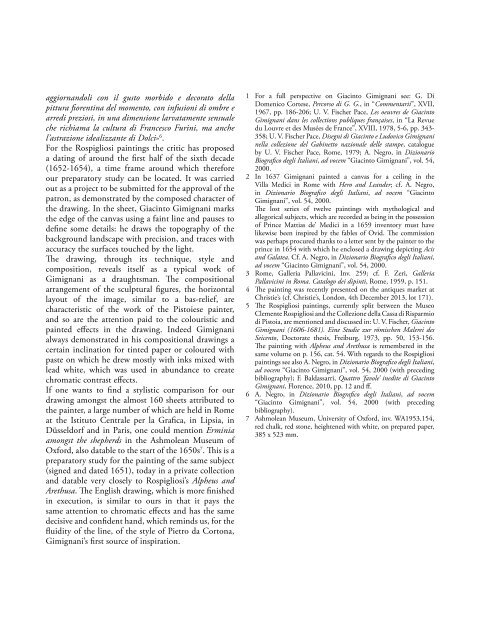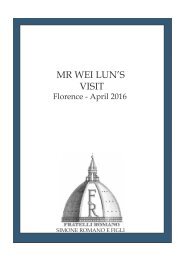A selection of master drawings 2016
- No tags were found...
Create successful ePaper yourself
Turn your PDF publications into a flip-book with our unique Google optimized e-Paper software.
aggiornandoli con il gusto morbido e decorato della<br />
pittura fiorentina del momento, con infusioni di ombre e<br />
arredi preziosi, in una dimensione larvatamente sensuale<br />
che richiama la cultura di Francesco Furini, ma anche<br />
l’astrazione idealizzante di Dolci» 6 .<br />
For the Rospigliosi paintings the critic has proposed<br />
a dating <strong>of</strong> around the first half <strong>of</strong> the sixth decade<br />
(1652-1654), a time frame around which therefore<br />
our preparatory study can be located. It was carried<br />
out as a project to be submitted for the approval <strong>of</strong> the<br />
patron, as demonstrated by the composed character <strong>of</strong><br />
the drawing. In the sheet, Giacinto Gimignani marks<br />
the edge <strong>of</strong> the canvas using a faint line and pauses to<br />
define some details: he draws the topography <strong>of</strong> the<br />
background landscape with precision, and traces with<br />
accuracy the surfaces touched by the light.<br />
The drawing, through its technique, style and<br />
composition, reveals itself as a typical work <strong>of</strong><br />
Gimignani as a draughtsman. The compositional<br />
arrangement <strong>of</strong> the sculptural figures, the horizontal<br />
layout <strong>of</strong> the image, similar to a bas-relief, are<br />
characteristic <strong>of</strong> the work <strong>of</strong> the Pistoiese painter,<br />
and so are the attention paid to the colouristic and<br />
painted effects in the drawing. Indeed Gimignani<br />
always demonstrated in his compositional <strong>drawings</strong> a<br />
certain inclination for tinted paper or coloured with<br />
paste on which he drew mostly with inks mixed with<br />
lead white, which was used in abundance to create<br />
chromatic contrast effects.<br />
If one wants to find a stylistic comparison for our<br />
drawing amongst the almost 160 sheets attributed to<br />
the painter, a large number <strong>of</strong> which are held in Rome<br />
at the Istituto Centrale per la Grafica, in Lipsia, in<br />
Düsseldorf and in Paris, one could mention Erminia<br />
amongst the shepherds in the Ashmolean Museum <strong>of</strong><br />
Oxford, also datable to the start <strong>of</strong> the 1650s 7 . This is a<br />
preparatory study for the painting <strong>of</strong> the same subject<br />
(signed and dated 1651), today in a private collection<br />
and datable very closely to Rospigliosi’s Alpheus and<br />
Arethusa. The English drawing, which is more finished<br />
in execution, is similar to ours in that it pays the<br />
same attention to chromatic effects and has the same<br />
decisive and confident hand, which reminds us, for the<br />
fluidity <strong>of</strong> the line, <strong>of</strong> the style <strong>of</strong> Pietro da Cortona,<br />
Gimignani’s first source <strong>of</strong> inspiration.<br />
1 For a full perspective on Giacinto Gimignani see: G. Di<br />
Domenico Cortese, Percorso di G. G., in “Commentarii”, XVII,<br />
1967, pp. 186-206; U. V. Fischer Pace, Les oeuvres de Giacinto<br />
Gimignani dans les collections publiques françaises, in “La Revue<br />
du Louvre et des Musées de France”, XVIII, 1978, 5-6, pp. 343-<br />
358; U. V. Fischer Pace, Disegni di Giacinto e Ludovico Gimignani<br />
nella collezione del Gabinetto nazionale delle stampe, catalogue<br />
by U. V. Fischer Pace, Rome, 1979; A. Negro, in Dizionario<br />
Biografico degli Italiani, ad vocem “Giacinto Gimignani”, vol. 54,<br />
2000.<br />
2 In 1637 Gimignani painted a canvas for a ceiling in the<br />
Villa Medici in Rome with Hero and Leander; cf. A. Negro,<br />
in Dizionario Biografico degli Italiani, ad vocem “Giacinto<br />
Gimignani”, vol. 54, 2000.<br />
The lost series <strong>of</strong> twelve paintings with mythological and<br />
allegorical subjects, which are recorded as being in the possession<br />
<strong>of</strong> Prince Mattias de’ Medici in a 1659 inventory must have<br />
likewise been inspired by the fables <strong>of</strong> Ovid. The commission<br />
was perhaps procured thanks to a letter sent by the painter to the<br />
prince in 1654 with which he enclosed a drawing depicting Acis<br />
and Galatea. Cf. A. Negro, in Dizionario Biografico degli Italiani,<br />
ad vocem “Giacinto Gimignani”, vol. 54, 2000.<br />
3 Rome, Galleria Pallavicini, Inv. 259; cf. F. Zeri, Galleria<br />
Pallavicini in Roma. Catalogo dei dipinti, Rome, 1959, p. 151.<br />
4 The painting was recently presented on the antiques market at<br />
Christie’s (cf. Christie’s, London, 4th December 2013, lot 171).<br />
5 The Rospigliosi paintings, currently split between the Museo<br />
Clemente Rospigliosi and the Collezione della Cassa di Risparmio<br />
di Pistoia, are mentioned and discussed in: U. V. Fischer, Giacinto<br />
Gimignani (1606-1681). Eine Studie zur römischen Malerei des<br />
Seicento, Doctorate thesis, Freiburg, 1973, pp. 50, 153-156.<br />
The painting with Alpheus and Arethusa is remembered in the<br />
same volume on p. 156, cat. 54. With regards to the Rospigliosi<br />
paintings see also A. Negro, in Dizionario Biografico degli Italiani,<br />
ad vocem “Giacinto Gimignani”, vol. 54, 2000 (with preceding<br />
bibliography); F. Baldassarri, Quattro ‘favole’ inedite di Giacinto<br />
Gimignani, Florence, 2010, pp. 12 and ff.<br />
6 A. Negro, in Dizionario Biografico degli Italiani, ad vocem<br />
“Giacinto Gimignani”, vol. 54, 2000 (with preceding<br />
bibliography).<br />
7 Ashmolean Museum, University <strong>of</strong> Oxford, inv. WA1953.154,<br />
red chalk, red stone, heightened with white, on prepared paper,<br />
385 x 523 mm.





